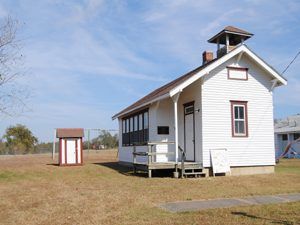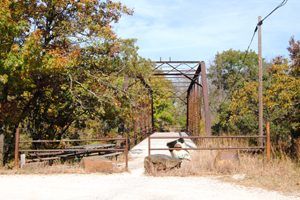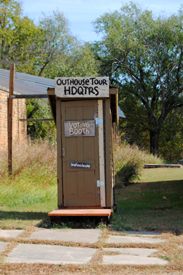“Elk Falls is a state of mind… There’s nothing like it anywhere.”
— Mil Penner, Exploring Kansas
In the heart of the Kansas Ozarks is the small town of Elk Falls, which touts itself as the “World’s largest living ghost town” and the “Outhouse Capital of the World.” Thriving as a mere shadow of its former self, the mid-nineteenth century settlement, at one time, attracted thousands of yearly visitors to its “Outhouse Tours” and other eccentric attractions.
Sitting on a wooded bend in the road not far from the Oklahoma border, the first settler to locate upon the townsite was a man named R.H. Nichols in February 1870. Soon after, establishing a townsite was conceived, and Nichols, with six other businessmen, formed a townsite company laying out lots and making plans for the new settlement. Nichols built a small house, which also served as a loan and real estate office; a general store was built, a drug store and blacksmith shop opened; the post office was established, and the school was taught to 25 pupils by Miss Dora Simmons at her father’s residence.
By 1871, the site was named Elk Falls, deriving its name from a nearby waterfall on the Elk River, and became the temporary county seat of Howard County. The same year, a school building was erected in a small one-story frame house, where services for the Methodist Episcopal Church were also held.
However, elections in 1872 and 1873 failed to establish a clear choice between Elk Falls, Peru, Boston, Longton, and Howard for the county seat. After a questionable election of 1873, citizens of Boston raided Elk Falls and took the county records and furnishings. The records were hidden in Cowley County, and the town of Boston posted armed guards to keep out the Howard County sheriff.
The bitterness became academic when Elk County was divided into Elk and Chautauqua Counties in 1875. Elk Falls fell within Elk County, and the town of Howard became the county seat due to its central location.
In 1875, E. A. Hall and L.J. Johnston constructed a grist and flour mill on the river near the falls, which was powered by a turbine water wheel. The three-story frame building cost $1600. Grinding wheat from locals and others who shipped it in, the mill provided flour throughout the state.
Several dams were built along the Elk River from logs, lumber, and timbers to provide a water supply for severe droughts that often plagued the area. Still, high waters destroyed them one after another during floods. Finally, a man named Jo Johansen, a Swede from Minnesota took over the mill and built the dam of sandstone rocks cemented together, which has withstood the floods for over a century.
In 1879, a Baptist Church was built, and in the following year, a Methodist Episcopal Church was built.
Elk Falls’ population peaked in 1880 at 513 people.
By 1883, the new and rising town had attracted many prospects, and numerous improvements had been made, increasing the population to more than five hundred residents. Much of the population was children, as the school included more than 200 students.
On November 15, 1892, the board of Elk County Commissioners voted to build an iron truss bridge over Elk River, connecting the dirt roads into the main thoroughfare leading into Elk Falls from the northeast. Built at the cost of $2,000, it was completed in 1893. The Pratt Truss Bridge was unique for its type since expansion joints were made from rollers rather than wheels. The bridge still stands today and is on the National Register of Historic Places.
Sometime in the late nineteenth century, the grist mill was closed, and the building moved to the south side of the river and was used to store hay.
Though the small town had two stores, two barbershops, a doctor’s office, a dentist, a drug store, and a feed store, the population had begun to fall by 1927, having only 269 residents.
When Kansas Highway 160 was built through Elk Falls in 1957, the traffic on the old steel bridge dwindled to almost nothing. And, when the Elk River experienced a dramatic flood in 1976, most of the wooden planks making up the bridge floor were taken by the turbulent waters. The old bridge was no longer feasible for repair or vehicular traffic, and the Elk County Commissioners voted to condemn the bridge and close it. However, plans to destroy the bridge were fortunately delayed, and in 1983, the bridge was preserved as a footbridge. In 1992, the Kansas State Historical Society made the bridge a historic site, and in 1994 was placed on the National Register of Historic Sites.
Today, while Elk Falls describes itself as a living ghost town, it also has to say: “We ain’t dead yet!” Not the typical tourist destination, this off-the-beaten-path town has done its best to stay alive. This is a place where the visitor can slow down, feel the soothing tranquility of the Falls, relax, and see a bit of history without the frantic pace of a city.
Several years ago, an Elk Falls resident got an idea to draw tourists by calling it the world’s largest living ghost town. Some people appreciated this idea at the time, while others weren’t so happy, preferring to remain anonymous in the dying town. However, the idea caught hold. Numerous artists and craftsmen began to converge on the dying town, and within a few short years, the ghost town was drawing thousands of visitors each year.
Though many artists and performers have since moved on, and Elk Falls is again making good on its “ghost town” claim, its falls are still running. An old attraction known as the Rock Garden, built in the 1930s, has been restored and is home to Elk Falls Pottery, an establishment that has been thriving for three decades.
The busiest time for tiny Elk Falls is the annual Outhouse Tour, held on the Friday and Saturday before Thanksgiving. In addition to some creative outhouses, visitors enjoy live music, handcrafts, food, and more.
“The Falls” can be seen at the east end of Montgomery Street, about three blocks east of the main street in Elk Falls.
Today, this small town is called home to just about 100 people. Elk Falls is about 35 miles northwest of Independence, Kansas, on U.S. 160.
Contact Information:
Friends of Elk Falls Association
P.O. Box 115
Elk Falls, Kansas 67345
© Kathy Alexander/Legends of America, updated August 2024.
Also See:




